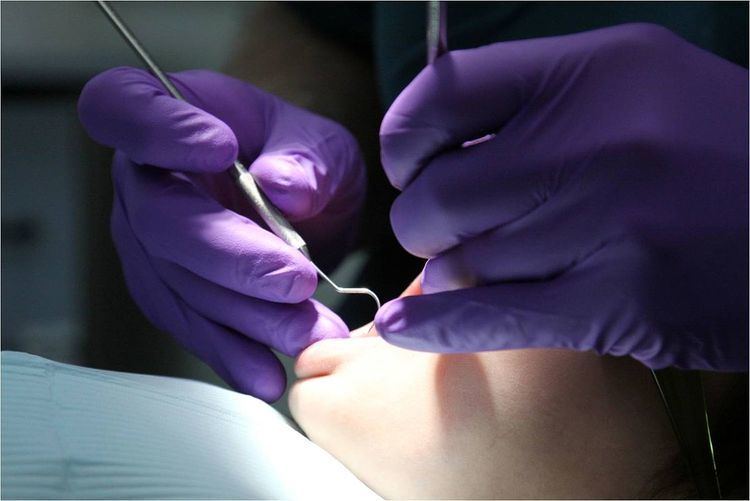 | ||
Medical gloves are disposable gloves used during medical examinations and procedures that help prevent cross-contamination between caregivers and patients. Medical gloves are made of different polymers including latex, nitrile rubber, polyvinyl chloride and neoprene; they come unpowdered, or powdered with cornstarch to lubricate the gloves, making them easier to put on the hands. Cornstarch replaced tissue-irritating Lycopodium powder and talc, but even cornstarch can impede healing if it gets into tissues (as during surgery). As such, unpowdered gloves are used more often during surgery and other sensitive procedures. Special manufacturing processes are used to compensate for the lack of powder. There are two main types of medical gloves: examination and surgical. Surgical gloves have more precise sizing with a better precision and sensitivity and are made to a higher standard. Examination gloves are available as either sterile or non-sterile, while surgical gloves are generally sterile.
Contents
History
Caroline Hampton became the chief nurse of the operating room when Johns Hopkins Hospital opened in 1889. When "(i)n the winter of 1889 or 1890" she developed a skin reaction to mercuric chloride that was used for asepsis, William Halsted, soon-to-be her husband, asked the Goodyear Rubber Company to produce thin rubber gloves for her protection. In 1894 Halsted implemented the use of sterilized medical gloves at Johns Hopkins.
The first disposable latex medical gloves were manufactured in 1964 by Ansell. They based the production on the technique for making condoms. These gloves have a range of clinical uses ranging from dealing with human excrement to dental applications.
Criminals have also been known to wear medical gloves during commission of crimes. These gloves are often chosen because their thinness and tight fit allow for dexterity. However because of the thinness of these gloves, fingerprints may actually pass through the material as glove prints, thus transferring the wearer's prints onto the surface touched or handled.
The participants of the Watergate burglaries infamously wore rubber surgical gloves in an effort to hide their fingerprints.
Powdered gloves
To facilitate donning of gloves, powders have been used as lubricants. Early powders derived from pines or club moss were found to be toxic. Talcum powder was used for decades but linked to postoperative granuloma and scar formation. Corn starch, another agent used as lubricant, was also found to have potential side effects such as inflammatory reactions and granuloma and scar formation.
Chlorination
To make them easier to don without the use of powder, gloves can be treated with Chlorine. Chlorination affects some of the beneficial properties of latex, but also eliminates soluble proteins that cause allergic reactions.
Elimination of powdered medical gloves
With the availability of non-powdered medical gloves that were easy to don, calls for the elimination of powdered gloves became louder. By 2016, healthcare systems in Germany and the United Kingdom had eliminated their use. In March 2016, the FDA issued a proposal to ban their medical use as well.
Powder-free medical gloves are used in medical cleanroom environments, where the need for cleanliness is often similar to that in a sensitive medical environment.
Alternatives to latex
Due to the increasing rate of latex allergy among health professionals, and in the general population, gloves made of non-latex materials such as polyvinyl chloride, nitrile rubber, or neoprene have become widely used. Chemical processes may be employed to reduce the amount of antigenic protein in Hevea latex, resulting in alternative natural-rubber-based materials such Vytex Natural Rubber Latex. However, non-latex gloves have not yet replaced latex gloves in surgical procedures, as gloves made of alternative materials generally do not fully match the fine control or greater sensitivity to touch available with latex surgical gloves. (High-grade isoprene gloves are the only exception to this rule, as they have the same chemical structure as natural latex rubber. However, fully artificial polyisoprene—rather than "hypoallergenic" cleaned natural latex rubber—is also the most expensive natural latex substitute available.) Other high-grade non-latex gloves, such as nitrile gloves, can cost over twice the price of their latex counterparts, a fact that has often prevented switching to these alternative materials in cost-sensitive environments, such as many hospitals. Nitrile is a synthetic rubber. It has no latex protein content and is more resistant to tearing. Also it is very resistant to many chemicals and is very safe for people who are allergic to latex protein. Nitrile gloves are the most durable type of disposable gloves. Although nitrile gloves are known for their durability, extra care should be taken while handling silver and other highly reactive metals because those substances can react with sulfur, an accelerant in nitrile gloves.
Double gloving
Double gloving is the practice of wearing two layers of medical gloves to reduce the danger of infection from glove failure or penetration of the gloves by sharp objects during medical procedures. This should better protect the patient against infections transmitted by the surgeon. A systematic review of the literature has shown double gloving to offer significantly more protection against inner glove perforation in surgical procedures compared to the use of a single glove layer. But it was unclear if there was better protection against infections transmitted by the surgeon . Another systematic review studied if double gloving protected the surgeon better against infections transmitted by the patient. Pooled results of 12 studies (RCTs) with 3437 participants showed that double gloving reduced the number of perforations in inner gloves with 71% compared to single gloving. On average ten surgeons/nurses involved in 100 operations sustain 172 single gloves perforations but with double gloves only 50 inner gloves would be perforated.This is a considerable reduction of the risk.
